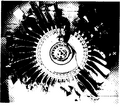United Airlines Flight 232 facts for kids

The airplane moments before the crash
|
|
| Accident summary | |
|---|---|
| Date | July 19, 1989 |
| Summary | Uncontained engine failure due to faulty titanium alloy, leading to loss of hydraulics and flight controls |
| Place | Sioux Gateway Airport Sioux City, Iowa, United States 42°24′29″N 96°23′02″W / 42.40806°N 96.38389°W |
| Passengers | 285 |
| Crew | 11 |
| Injuries (non-fatal) | 172 |
| Fatalities | 111 |
| Survivors | 184 |
| Aircraft type | McDonnell Douglas DC-10-10 |
| Airline/user | United Airlines |
| Registration | N1819U |
| Flew from | Stapleton International Airport, Denver, Colorado |
| Stopover | O'Hare International Airport, Chicago, Illinois |
| Flying to | Philadelphia International Airport, Philadelphia, Pennsylvania |
United Airlines Flight 232 was a regular flight from Stapleton International Airport in Denver, Colorado, to O'Hare International Airport in Chicago. On July 19, 1989, the DC-10 airplane flying this route had a major problem. Its engine, located in the tail, broke apart. This caused the plane to lose all its flight controls, making it very hard to steer.
The pilots tried their best to land the plane safely in Sioux City, Iowa. Sadly, the plane crash-landed. There were 296 people on board. Out of them, 111 people died, but 185 people survived the accident. This event is remembered for the amazing teamwork of the flight crew.
Contents
What Happened to Flight 232?
United Airlines Flight 232 was flying high in the sky when suddenly, the engine at the back of the plane broke apart. Pieces of the engine flew out with great force. This is called an "uncontained engine failure."
These flying pieces cut through the plane's important hydraulic lines. Hydraulic lines are like the plane's veins. They carry fluid that helps move the flight controls, like the flaps and rudder. When these lines were cut, the pilots could no longer steer the plane normally.
Losing Control of the Plane
Without the hydraulic system, the pilots could not use the plane's steering surfaces. These surfaces are on the wings and tail. They help the plane turn, climb, and descend. It was like trying to drive a car without a steering wheel or brakes.
The pilots were in a very difficult situation. The plane started to fly in an uncontrolled way. It would turn and dive on its own. The crew had to find a new way to control the aircraft.
The Crew's Amazing Teamwork
The pilots, Captain Al Haynes, First Officer William Records, and Second Officer Dudley Dvorak, worked together. They also got help from a pilot who was a passenger, Dennis Fitch. He was a DC-10 flight instructor.
They discovered they could use the power of the two working engines on the wings to steer the plane. By changing the thrust (power) of each engine, they could make the plane turn left or right. This was a very unusual way to fly.
Preparing for an Emergency Landing
The crew knew they had to land the plane quickly. They aimed for Sioux Gateway Airport in Sioux City, Iowa. Air traffic controllers and emergency teams on the ground got ready. They prepared for a very difficult landing.
The pilots tried to guide the plane down. They used the engine power to control its direction. It was a bumpy and fast descent. The plane was very hard to control.
The Crash Landing in Sioux City
On July 19, 1989, the plane approached the airport. It was coming in too fast and was not stable. The crew did their best to line up with the runway. However, the plane hit the ground very hard.
The plane broke into several pieces as it slid across the runway. It then burst into flames. Emergency crews rushed to the scene. They worked quickly to help the people inside.
Rescue Efforts and Survivors
Despite the fiery crash, many people survived. The quick response of the emergency teams was very important. Firefighters, paramedics, and volunteers helped pull people from the wreckage.
The crash was a terrible event, but the high number of survivors was remarkable. This was partly due to the crew's efforts to guide the plane. It was also due to the fast and brave work of the rescue teams.
Why Did the Engine Fail?
After the accident, experts investigated what happened. They found that the engine failure was caused by a tiny crack. This crack was in a part of the engine called the fan disk. The fan disk is a large metal part that spins very fast.
The crack grew over time. It was caused by a problem in how the metal was made. The metal was a special type of titanium alloy. This small flaw eventually led to the entire fan disk breaking apart during the flight.
Lessons Learned from Flight 232
The accident taught important lessons about airplane safety. Investigators learned more about how metal parts can fail. This led to better ways of checking engine parts for tiny cracks.
Airlines and manufacturers improved their safety checks. They also looked at how pilots are trained for extreme emergencies. The crew's ability to use engine thrust for steering was a new discovery. This knowledge helped improve pilot training for future difficult situations.
Images for kids
See also
 In Spanish: Vuelo 232 de United Airlines para niños
In Spanish: Vuelo 232 de United Airlines para niños




